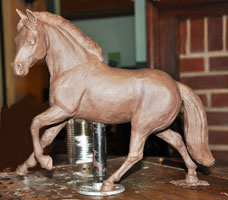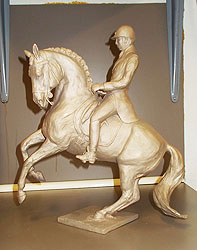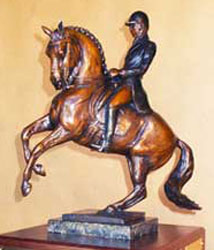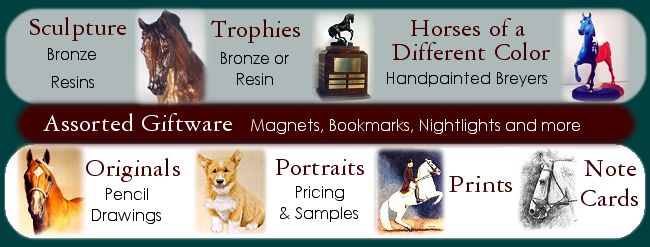

| The art of bronze casting goes back to ancient
times. The Chinese were thought to be the first to use bronze, an alloy of copper, to make artifacts and weapons. The Ancient Greeks and Romans made statues and weapons of bronze many of which we can see in museums today. Bronze melts at a temperature of more than 2,000 degrees Farenheit. In liquid form it is more viscus than water, seeking every detail of a mold. It gives you sharp edges and life-like detail. When polished it can look like gold or be given a patina of almost any color. And occasionally it can be handpainted. I work with Art Foundry Carpino of Houston, Texas. They specialize in art casting only, using modern methods and silicon bronze, a beautiful and very strong material. THE PROCESS: Madoc All Dun clay model.  First a model is made of First a model is made of clay or resin to size. Once the clay model is approved by the client it is taken to the foundry where a rubber mold is made of it. Sometimes multiple molds are made and the sculpture is cast in pieces that are welded together after casting. Next they pour a special wax into the mold to create a hollow reproduction of the sculpture with the walls of the sculpture being no more than 1/8" - 1/4" thick. At this point I go to the foundry to approve the wax and see that all the details are correct. The foundry then adds gates and sprews necessary for a successful casting. The gating will allow the bronze a path to flow in and out of the mold evenly. Next a ceramic mold is made around the wax sculpture and its gates and sprews. This is the "lost wax" process. The ceramic mold is fired in a kiln and the wax evaporates leaving all the details of the sculpture inside. The molten bronze is poured into the warm mold. This is the most dangerous part of the process. A spill of bronze can go right through a steel toed boot. The mold and the casting must cool for 24 hours. Then the foundry sets to work on removing the sculpture from the mold. The ceramic mold is destroyed in the process. That is why they made a rubber mold of the original model. (Just in case things don't go as planned.)  The sprews and gating must be removed and any defects in fhe casting repaired. Skilled artisans with cutting torch, chisell and sand blasting bring the artwork to life. US Dressage Finals Perpetual Trophy after casting with gates and sprews removed. Next a patina can be applied. A patina is an acidic mixture which when applied with heat bonds to the metal and protects the bronze against corrosion.  The patina can be a uniform color, usually brown, or the bronze can be hand painted with oils or acrylic paints in a realistic manner. Either way the metal must be sealed against the elements to prevent corrosion. In the final step the sculpture is mounted on a base. Often wood or stone (granite or marble). The base material comes from a different supplier and must be ordered in advance to be ready to mount the sculpture. The wood or stone must be drilled and the bronze screwed securely into place. As a finishing touch a brass plate identifying and naming the piece can be added. If it is to be a trophy, multiple brass plates and engraving may be necessary. The whole process of creating a bronze can take 6 to 18 months or longer. In addition to the artist, a group of skilled artisans at the foundry make this all possible. And the skills of a wood worker and a stone cutter who make the bases. All these people come together to create your portrait or unique trophy bronze. Call Olva at: 281-373-9304 or email to discuss a bronze portrait. See page on prices and ordering for more information. Click here to see Limited Edition Bronzes for sale. Click here to see Horse and Rider Bronzes for example. Click here to see Limited Edition Resin Castings. Click here to see Works in Progress. Click here to see Pencil Originals for sale. Click here for information about Pricing and Scheduling for a bronze portrait. |


